As an avid tea drinker, I am always on the lookout for unique and delicious varieties of tea. One such gem that I recently discovered is Milk Oolong Tea. Made from the Camellia sinensis plant, this tea not only offers a delightful creamy flavor but also provides a range of health benefits.
Milk Oolong tea is rich in antioxidants, including EGCG, which can boost heart health and help protect against heart diseases and type 2 diabetes. Its anti-inflammatory properties can reduce inflammation in the arteries and blood vessels, thus lowering blood pressure and preventing blood clots. Additionally, this tea has been shown to lower LDL cholesterol, increase metabolism, aid in weight loss, and help regulate blood sugar levels. It even provides a dose of vitamin C, which can boost immunity.
Drinking Milk Oolong Tea is not only a pleasurable experience but also a way to improve overall health.
Key Takeaways:
- Milk Oolong Tea is made from the Camellia sinensis plant and has a delightful creamy flavor.
- It is rich in antioxidants, including EGCG, which can boost heart health and protect against heart diseases and type 2 diabetes.
- The anti-inflammatory properties of Milk Oolong Tea can reduce inflammation in the arteries and blood vessels, lowering blood pressure and preventing blood clots.
- It has been shown to lower LDL cholesterol, increase metabolism, aid in weight loss, and help regulate blood sugar levels.
- Milk Oolong Tea provides a dose of vitamin C, which can boost immunity and improve overall health.
What Is Oolong Tea?
Oolong tea, derived from the Camellia sinensis plant, is a popular and beloved beverage primarily cultivated in China and Taiwan. With its rich history and unique flavors, oolong tea has gained recognition worldwide for its distinct characteristics.
Oolong tea undergoes partial oxidation, a process that sets it apart from other types of tea. This oxidation gives oolong tea a wide range of flavors, offering a delightful and diverse experience for tea enthusiasts.
There are several types of oolong tea, each with its own aromatic profile and taste. Some of the most well-known varieties include:
- Milk Oolong
- Da Hong Pao
- Bai Jiguan
- Tieguanyin
These oolong teas come in different degrees of oxidation, such as light, dark, and green oolongs, resulting in a variety of flavors and aromas to suit every palate.
Whether you prefer the creamy and smooth taste of Milk Oolong or the robust and earthy notes of Da Hong Pao, there is an oolong tea variety to captivate your taste buds.
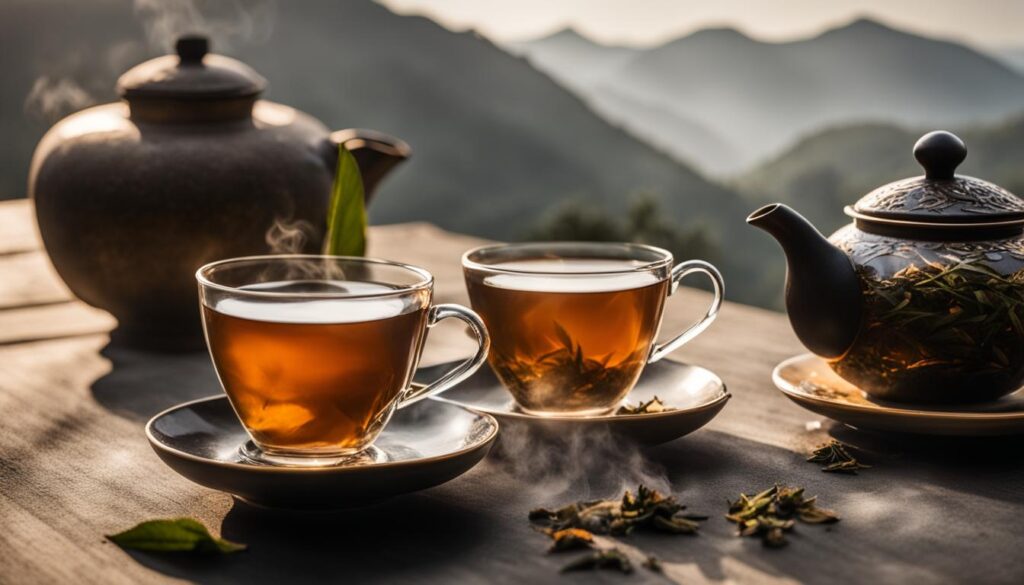
Origins of Oolong Tea
Oolong tea has a long-standing history rooted in Chinese and Taiwanese cultures. It has been cherished for centuries, celebrated for its exquisite taste and health-promoting properties.
The precise origins of oolong tea trace back to the 18th century in the Fujian province of China. The unique cultivation and processing methods used in this region produced a tea prized for its complexity and depth of flavors.
Over time, oolong tea gained popularity beyond China, captivating tea enthusiasts worldwide with its captivating aromas and flavors. Today, the production of oolong tea extends to Taiwan, where it has become an integral part of Taiwanese culture and tea traditions.
Whether enjoyed in a traditional tea ceremony or a casual afternoon break, oolong tea continues to be cherished for its unmatched quality and remarkable taste.
7 Health Benefits of Oolong Tea
Oolong tea offers several health benefits. It is rich in antioxidants, particularly EGCG, which can boost heart health and protect against heart diseases and type 2 diabetes. Oolong tea also has anti-inflammatory properties that can reduce inflammation in the arteries and blood vessels, lowering blood pressure and preventing blood clots. Regular consumption of oolong tea has been shown to lower LDL cholesterol, increase metabolism, aid in weight loss, and regulate blood sugar levels. It also provides a dose of vitamin C, which boosts immunity and helps fight off common colds and flu.
Benefits of Oolong Tea:
- Improved Heart Health: Oolong tea’s antioxidants can help protect against heart diseases and type 2 diabetes.
- Reduced Inflammation: Oolong tea’s anti-inflammatory properties can lower blood pressure and prevent blood clots.
- Lowered Cholesterol: Regular consumption of oolong tea has been shown to lower LDL cholesterol levels.
- Weight Loss Support: Oolong tea can increase metabolism and aid in weight loss.
- Regulated Blood Sugar: Oolong tea can help regulate blood sugar levels.
- Boosted Immunity: Oolong tea provides a dose of vitamin C to support a healthy immune system.
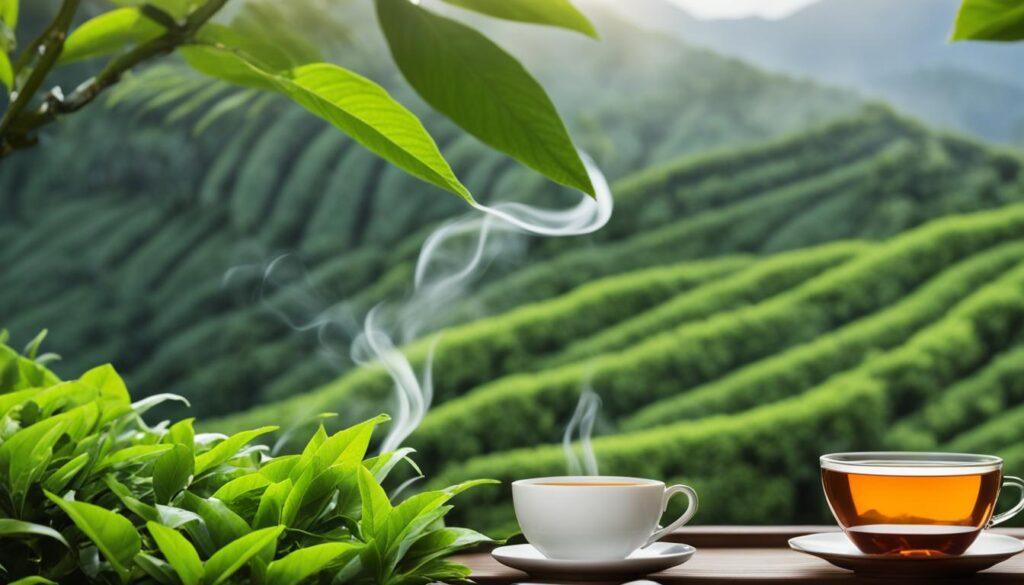
“Oolong tea’s antioxidants can help protect against heart diseases and type 2 diabetes.”
With its numerous health benefits, oolong tea is a delicious and nutritious addition to a balanced diet. Incorporating a cup or two of oolong tea into your daily routine can contribute to better heart health, reduced inflammation, improved cholesterol levels, weight management, regulated blood sugar, and a stronger immune system.
Side Effects of Oolong Tea
While oolong tea offers numerous health benefits, it’s essential to be aware of potential side effects that some individuals may experience. Understanding these side effects can help you make an informed decision about including oolong tea in your diet.
Pregnancy and Breastfeeding
During pregnancy and breastfeeding, it’s important to consume oolong tea in moderation. The caffeine content in oolong tea may have adverse effects and should be limited to no more than 2 cups per day. Excessive caffeine intake can lead to nausea, dizziness, and even affect the baby’s health. If you’re pregnant or breastfeeding, it’s advisable to consult with your healthcare provider before consuming oolong tea.
Caffeine Sensitivity
Individuals with caffeine sensitivity should exercise caution when consuming oolong tea. Caffeine sensitivity can manifest as irregular heartbeat, irritability, digestive issues, and sleep disturbances. If you experience any of these symptoms after consuming oolong tea, it’s best to reduce or avoid your intake and opt for caffeine-free alternatives.
Bone Health Concerns
Oolong tea may affect calcium and iron absorption, which can be a concern for individuals with bone conditions such as osteoporosis. If you have existing bone health issues or are concerned about calcium and iron absorption, it’s advisable to consult with your healthcare provider before integrating oolong tea into your routine.
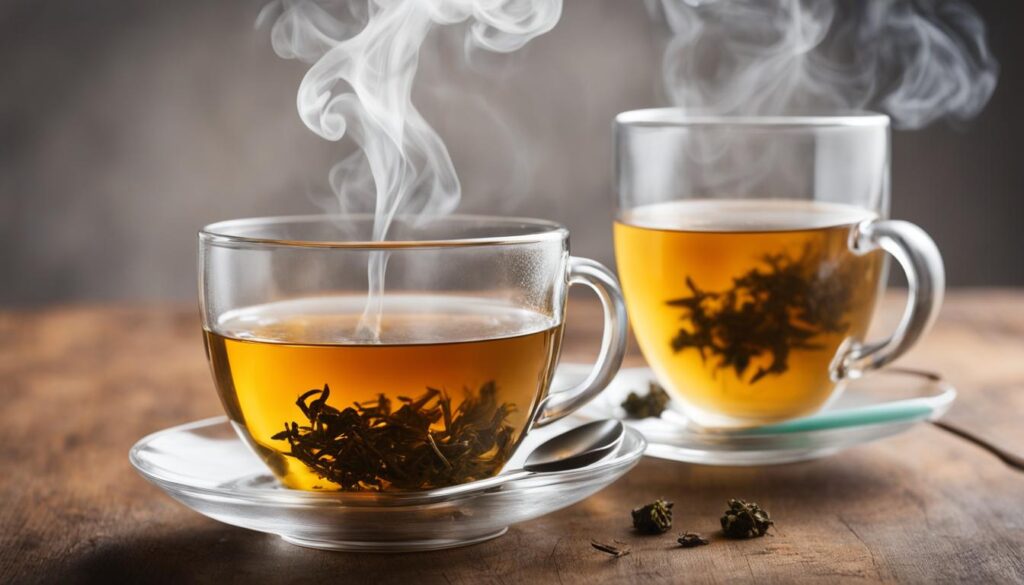
It’s important to note that the side effects mentioned above are primarily associated with excessive or inappropriate consumption of oolong tea. As with any dietary change, it’s always recommended to listen to your body and make adjustments based on your individual needs and health conditions.
How to Make Oolong Tea
Making oolong tea is a simple and enjoyable process. To brew oolong tea, you will need quality oolong tea leaves, fresh water, a teapot or tea infuser, a tea kettle, and cups or mugs. Follow these steps to make the perfect cup of oolong tea:
- Measure the tea leaves: Start by measuring the oolong tea leaves. Use approximately 1 teaspoon of tea leaves per 8-ounce cup of water.
- Heat the water: Heat fresh water to the appropriate temperature based on the type of oolong tea you are using. Different oolong teas may require different water temperatures. Generally, 180°F to 200°F (82°C to 93°C) is suitable for most oolong teas.
- Preheat the teapot or infuser: Preheat your teapot or tea infuser by rinsing it with hot water. This helps maintain the temperature of the brewing water and enhances the flavor of the oolong tea.
- Add the tea leaves: Place the oolong tea leaves into the teapot or infuser. Use one teaspoon of tea leaves per cup of water.
- Pour in the hot water: Carefully pour the hot water over the tea leaves in the teapot or infuser. Ensure that the leaves are fully submerged in the water.
- Steep the tea: Allow the tea to steep for the recommended amount of time based on the type of oolong tea you are using. Lighter oolongs typically require 2-3 minutes of steeping, while darker oolongs may need 3-5 minutes to fully develop their flavors.
- Strain and serve: After the desired steeping time, remove the tea leaves from the teapot or infuser. Pour the brewed oolong tea into cups or mugs, and savor the aromatic flavors of your homemade oolong tea.
Enjoy the process of brewing oolong tea and experimenting with different tea leaves and steeping times to discover your preferred flavors. Whether you prefer a light and floral oolong tea or a rich and robust variation, the key is to find the perfect balance of taste and aroma that suits your palate.
In the next section, we will explore how to enhance your oolong tea experience by adding milk for a creamy twist.
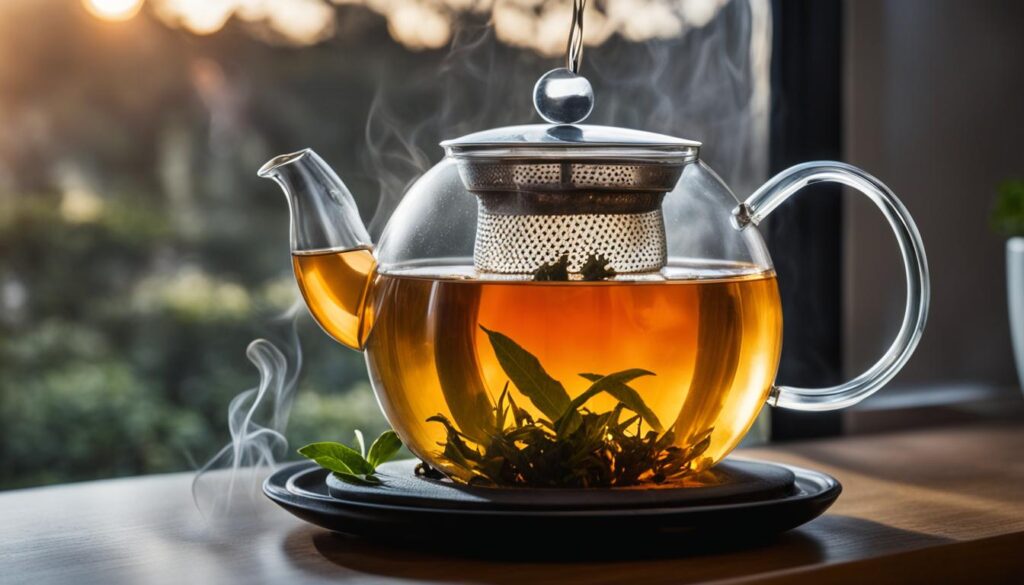
How to Make Oolong Tea with Milk
Adding milk to oolong tea can create a creamy and delightful beverage. To make oolong tea with milk, choose a darker oolong tea variety such as Milk Oolong or Da Hong Pao. Brew the oolong tea according to the instructions mentioned earlier. Once the tea is brewed, add milk to taste. You can use cow’s milk or alternative milk options such as almond or soy milk. Stir well and enjoy the creamy and flavorful oolong milk tea.
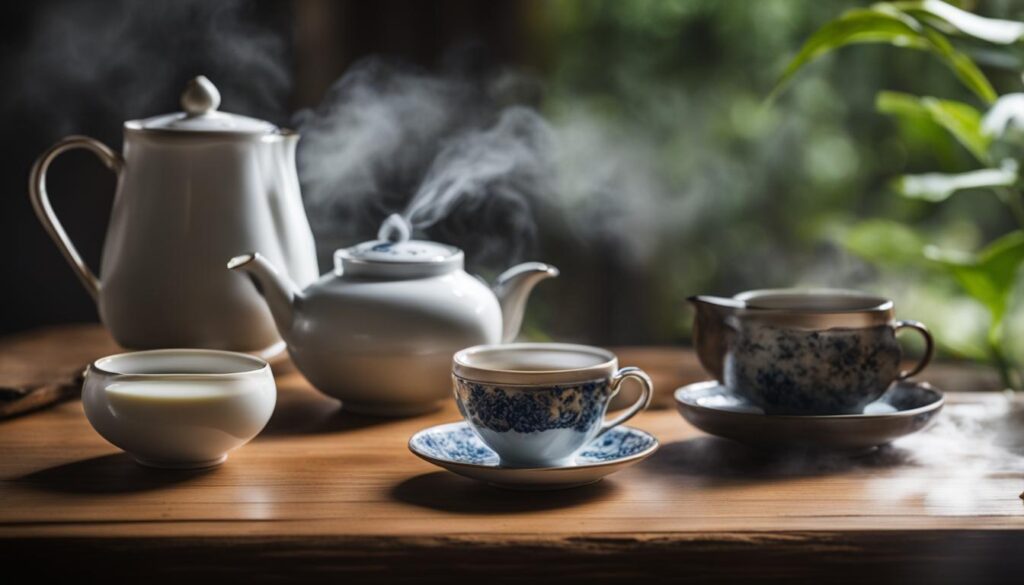
Simple Recipe for Oolong Milk Tea
Here’s a simple recipe for making oolong milk tea:
- Brew 2 teaspoons of oolong tea leaves in hot water for 3-5 minutes.
- Strain the brewed tea into a cup.
- Add 1/4 cup of milk (or adjust according to your preference).
- Stir well until the tea and milk are thoroughly combined.
- Sweeten with honey or sugar if desired.
- Enjoy your homemade oolong milk tea!
Experiment with different ratios of tea to milk and add your favorite flavors such as vanilla or cinnamon to create your own unique oolong milk tea recipe.
Oolong Tea Hot or Cold
Oolong tea offers the flexibility of being served hot or cold, making it suitable for any weather or personal preference. When the temperature drops, hot oolong tea provides a comforting and soothing experience. To serve hot oolong tea, follow the previously mentioned brewing instructions, ensuring you steep the tea leaves to perfection. Once brewed, pour the hot tea into cups or mugs, ready to warm you up during colder months or act as a revitalizing morning beverage.
Alternatively, iced oolong tea is a refreshing option that is perfect for warmer weather. The cold brew method is the key to achieving a delicious iced tea. Simply steep the tea leaves in cold water for several hours, allowing the flavors to infuse gradually. Once ready, serve the chilled oolong tea over ice, and for an added touch, garnish with a slice of lemon or a sprig of mint. This delightful combination creates a revitalizing and invigorating drink that is perfect for hot summer days.
Whether you prefer the comforting embrace of hot oolong tea or the refreshing quench of iced oolong tea, this versatile beverage is sure to please. Experiment with different brewing methods and serving styles to find your perfect cup of oolong tea, tailored to your unique taste preferences and serving needs.
FAQ
What are the benefits of drinking Milk Oolong Tea?
Milk Oolong tea offers a variety of health benefits. It is rich in antioxidants, can boost heart health, protect against heart diseases and type 2 diabetes, reduce inflammation, lower blood pressure, prevent blood clots, lower cholesterol, aid in weight loss, regulate blood sugar levels, and boost immunity.
What is Oolong Tea?
Oolong tea is made from the Camellia sinensis plant and is primarily grown in China and Taiwan. It comes in different flavors, such as light, dark, and green oolongs, each with its own unique aromas and tastes.
What are the health benefits of Oolong Tea?
Oolong tea has several health benefits. It can boost heart health, reduce inflammation, lower blood pressure, prevent blood clots, lower cholesterol, aid in weight loss, regulate blood sugar levels, and boost immunity.
What are the side effects of Oolong Tea?
While Oolong tea has numerous health benefits, it is important to be aware of potential side effects. Pregnant and breastfeeding women should limit their consumption due to the caffeine content, which can cause nausea and dizziness. Oolong tea may also upset a breastfeeding baby’s stomach. Individuals who are sensitive to caffeine should avoid Oolong tea, as it can cause irregular heartbeat, irritability, and digestive issues. Oolong tea may affect calcium and iron absorption, which can be a concern for individuals with bone conditions such as osteoporosis.
How to make Oolong Tea?
To brew Oolong tea, you will need quality Oolong tea leaves, fresh water, a teapot or tea infuser, a tea kettle, and cups or mugs. Start by measuring your Oolong tea leaves and heating the water to the appropriate temperature based on the type of Oolong. Preheat your teapot or infuser, add the Oolong tea leaves, and pour in the hot water. Steep the tea for the recommended amount of time based on the type of Oolong. Finally, pour the brewed Oolong tea into your cup or mug and savor the flavors.
How to make Oolong Tea with Milk?
To make Oolong tea with milk, choose a darker Oolong tea variety such as Milk Oolong or Da Hong Pao. Brew the Oolong tea according to the instructions mentioned earlier. Once the tea is brewed, add milk to taste. You can use cow’s milk or alternative milk options such as almond or soy milk. Stir well and enjoy the creamy and flavorful Oolong milk tea.
Can Oolong Tea be served hot or cold?
Yes, Oolong tea can be served hot or cold, depending on personal preference and weather conditions. Hot Oolong tea is comforting and soothing, perfect for enjoying during colder months or as a morning beverage. Iced Oolong tea can be made by steeping the tea leaves in cold water for several hours. Serve the chilled Oolong tea over ice and garnish with a slice of lemon or a sprig of mint for a refreshing summer drink.